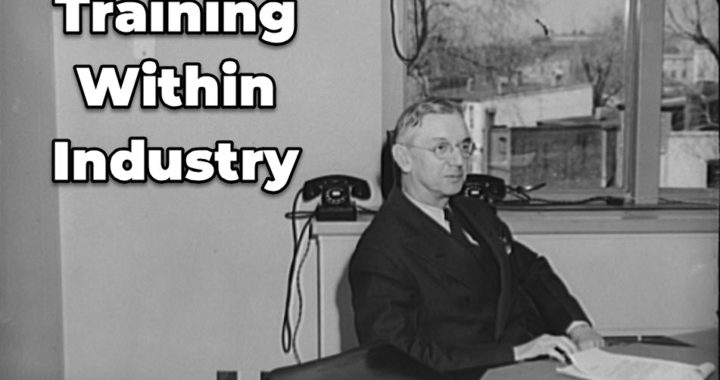The Training Within Industry (TWI) was a United States training program set for private industry companies to effectively and efficiently support equipment production efforts during World War II. It ran from 1940-1945 and it was developed by C.R. Dooley, Walter Dietz, M.J. Kane and William Conover. These men were training directors at their respective companies and rendered their services on loan by their employers while receiving no additional compensation from the Government. In 1943, many of the directors involved with TWI were founding members of the Association of Training Directors today known as the Association for Talent Development (ATD). Yet, despite this strong connection, little or no mention is made about TWI on ATD publications or any current learning networks such as the Learning Guild, Training Industry, Training Magazine or even the International Society for Performance Improvement (ISPI). TWI set the foundational methodology for effective training and development then and is even highly relevant today. As a fun fact, TWI is said to also have set the main principles leading to what is known today as the Lean methods for performance improvement.
Background
The foundational concepts leading to TWI are captured in Charles R. Allen’s book The Instructor, the Man, and the Job published in 1919. Yes, that’s not a typo, the year was 1919, much earlier than any common notion of the origins of training and instructional design today. Allen was a vocational instructor at the Massachusetts State Board of Education and Kane had participated in his WWI programs (Dooley, 1945, p.185). According to Bianchi and Giorcelli (2022), Allen was hired by the U.S. Government’ Emergency Fleet Corporation to develop training programs in 1917 to support the ship building and dry dock efforts in World War I (p.7). It was here that C.R. Allen modified the Herbartian steps of “Show, Tell, Do, Check” into “Preparation, Presentation, Application, and Inspection (or test)”. The contributions of C.R. Allen to the training industry, influenced Dooley, Dietz and Kane’s successful execution of the TWI program. Another significant fact about C.R. Allen’s book is that it provided a full prescriptive structure for an independent Training and Development function, led by a training director, supported by training and job coordinators as well as a functional train-the-trainer methodology known as the J-methods.
Instead of much discussion on learning difficulties, choice of methods and such, there was a simple straight formula that would work practically every time.
The Training Within Industry Report 1940-1945
The J Programs
The job programs or “J Programs” as they are known today, were the result of targeted methods crafted by the TWI directors. The methods expanded C.R. Allen’s instructional systems design strategies and focused on these foundational principles for any training program:
- It must be of utter simplicity.
- It must be documented and utilizing a minimum of time.
- It must be based on demonstration and practice “learning by doing” rather than theory.
- It should provide “multipliers” to spread the training by coaching selected workers as trainers.
Job Instruction (JI)
Glenn Gardiner, a TWI Director from the New Jersey district, worked with Mr. Kane to roll out the first job instruction program and the following resulted in a pocket card used as a performance support tool for supervisors who became TWI Instructors.
Practical methods to guide you in instructing a new man on a job or a present worker on a new job or a now skill.
FIRST, here’s what you must do to yet ready to teach a job :
- Decide what the learner must be taught in order to do the job efficiently, safely, economically and intelligently.
- Have the right tools, equipment, supplies and material ready.
- Have the work place properly arranged, just as the worker will be expected to keep it.
THEN, you should instruct the learner by the following four basic steps :
STEP I—PREPARATION (of the learner)
- Put learners at ease.
- Find out what they already knows about the job.
- Get them interested and desirous of learning the job.
STEP II—PRESENTATION (of the operations and knowledge)
- Tell, Show, Illustrate, and Question them in order to transfer the new knowledge and operations.
- Instruct slowly, clearly, completely and patiently, one point at a time.
- Check, question and repeat.
- Make sure they really learn aka knowledge transfer has occurred.
STEP III—PERFORMANCE TRY-OUT
- Test learners by having them perform the job.
- Ask questions beginning with what, why, how, who, when, or where.
- Observe performance, correct errors, and repeat instructions if necessary.
- Continue until you know they know.
STEP IV—FOLLOW-UP
- Put him “on his own.”
- Check frequently to be sure tie follows instructions.
- Taper off extra supervision and close follow-up until they are qualified to work with normal supervision.
REMEMBER—If the learners have not learned, the teacher hasn’t taught.
Training Within Industry Summary Report, 1945, p. 203
This instructional video shows the JI method in action
Job Relations (JR)
The job relations program focused on the needs of workers and the coaching strategy for supervisors to support them in these principles and steps:
- Everyday recognition of people as individuals.
- Letting people know how they are getting along. Giving people a chance to talk over in advance the things that affect them.
- Giving credit when due.
- Making best use of people’s ability.
The four steps were:
- Get the facts.
- Weigh and decide.
- Take action.
- Check results.
Job Methods (JM)
The job methods program seems to combine some of the aforementioned principles and steps and was presented as:
A practical plan to help you deliver GREATER QUANTITIES of QUALITY products in LESS TIME by making the best use of Manpower, Machines and Materials.
STEP I—BREAK DOWN the job.
- List all the details of operations, moves, inspections and delays, while operators are:
- Moving Materials
- Working with Machines
- Working with Hands and Tools
STEP II—QUESTION every detail.
- Use these types of questions:
WHY is it necessary?
WHAT is its purpose?
WHERE should it be done?
WHEN should it be done?
WHO is best qualified to do it?
HOW is ‘the best way’ to do it?
- Question product design, material, material handling, layout, set-ups, tools and equipment, machines, operator qualifications, work places and operations.
STEP III—DEVELOP the new method.
- ELIMINATE unnecessary details.
- COMBINE details when practical.
- REARRANGE to get better sequences.
- SIMPLIFY all necessary details.
- Make the work easier and safer.
- Preposition materials, tools and equipment at the best places in the proper work-area.
- Gravity-feed and Drop-delivery.
- Let both hands do useful work.
- Jigs and Fixtures for holding.
- Discuss your idea with others.
- Write up your suggestion.
STEP IV—APPLY the new method.
- Sell your suggestion to the boss.—Get his approval for a trial.
- Sell the new method to operators.—Give it a fair test.
- Safety? Quality? Quantity? Cost?
- Get final approval from all.
- Put it into effect. Use it until a better way is developed.
- Give credit where credit is due.
Training Within Industry Summary Report, 1945, p. 235 (in pdf)
Check out this great video for more historical background.
Implications for Today
TWI was a resounding success and helped us win World War II. As a fun fact, TWI J Programs became the foundational principles for the Lean process improvement methodology. Learning about TWI has left me with several questions about my professional development, higher ed and the training industry.
- Why is TWI not a foundational piece of higher ed curricula for instructional design?
- Why is TWI not common knowledge in all learning networks?
- Why did the private sector (except for manufacturing) stop using TWI?
There’s evidence to suggest that TWI may have led or directly influenced the creation of the Association for Training Directors in 1943, what is known today as the Association for Talent Development (ATD). I reached out to ATD to get the names of the 15 founding members who were industry leaders in oil, manufacturing and telecom. Unfortunately, the search continues. However, by analyzing all the guidance created by the TWI effort, it could be concluded that it was a precursor to the Analyze, Design, Develop, Implement and Evaluate (ADDIE) framework, Instructional Systems Design and performance improvement. It can also be evidence that most training and development best practices known today are directly derived from the J Programs.
If you know the answers to these questions, please share. This is the first of a series of articles I plan to write about the impact of TWI for enterprise learning.
Sources
Bianchi, N., & Giorcelli, M. (2022). The dynamics and spillovers of management interventions: Evidence from the training within industry program. Journal of Political Economy, 130(6), 000-000.

